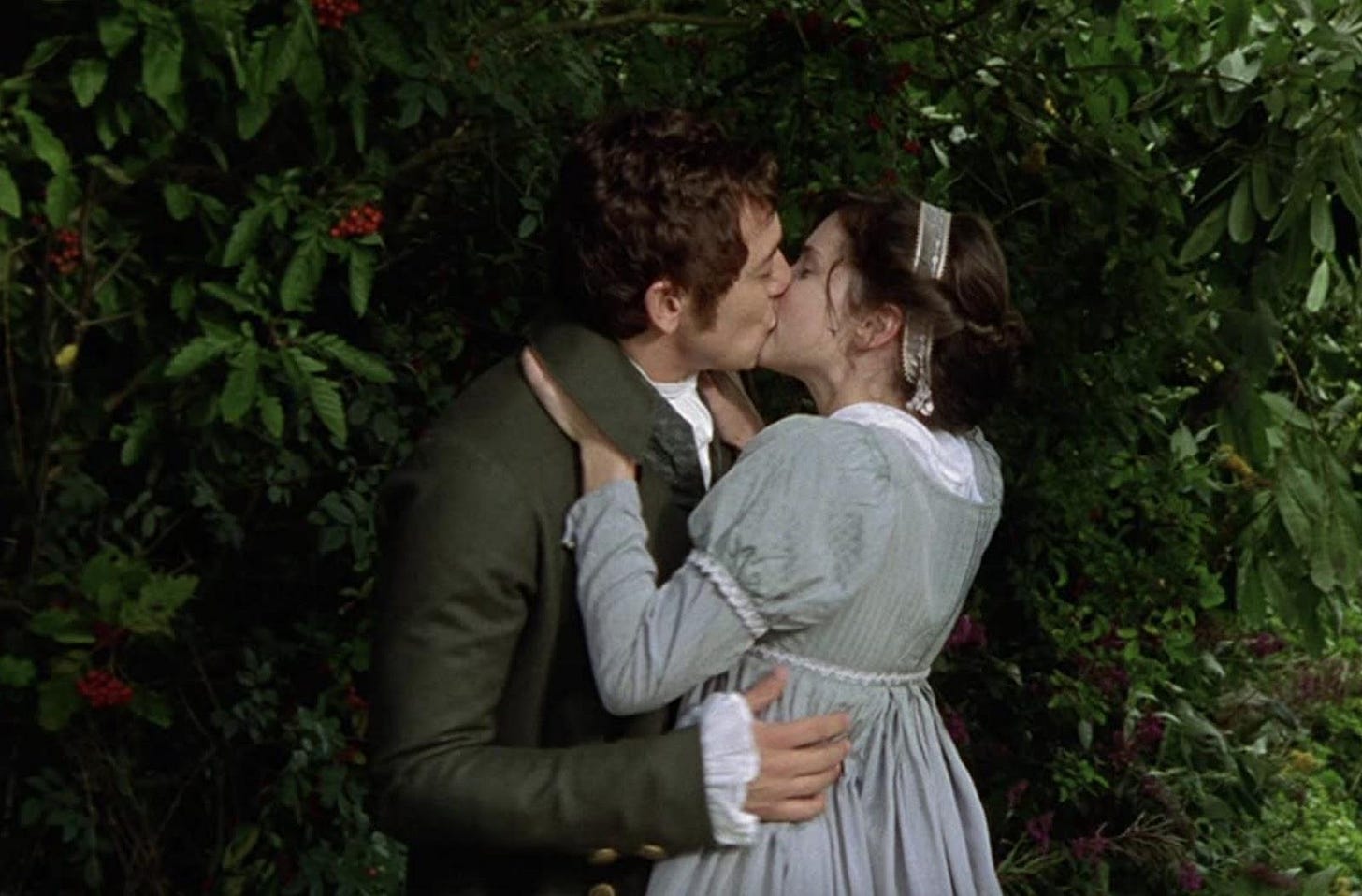Jane Austen and the Romcom
Stories like the classic ‘Pride and Prejudice’ live on in our romcoms because they mix examinations of society and power with plots about love and marriage
When I first started my Substack about Jane Austen, during the pandemic and in an attempt to fill up some extra hours with joy and connection, I really wasn’t sure where the Austen canon intersected with that wonderful genre of literature known as the romcom, or Romantic Comedy.
As an English major and postgrad stomping around London back in the 90s, I had learned from the best how to read authors like Austen and Dickens with a view to their larger philosophies and theories and to analyze how these authors packed social ideas — sometimes radical ones — into their stories.
But it was only later, as a young married person living in Southern California, that I reread Mansfield Park — a book that in its essence is about a group of young people gathered unchaperoned on an English estate and the things they do to each other. I discovered Austen’s complicated, stylized language — which innovated and influenced the art of the novel — also contains an awful lot of romance, desire, and fun.
Even before embarking on my Substack adventure, I was vaguely aware of a fandom around Austen’s classics. Her contributions to the canon have been transformed into apocalypse films like Pride and Prejudice and Zombies and Sense and Sensibility and Sea Monsters. I knew that the scene in the 1995 BBC adaptation of Pride and Prejudice when Colin Firth’s Mr. Darcy emerges from a lake swim and saunters across his lush parklands in a wet white tunic had become iconic, first on its own and later helped by the fictional P&P-obsessed Bridget Jones, which I had read as a brand new mom nursing my first daughter in San Diego. I knew that Jane Austen fanfic had taken off, and that the Jane Austen Society of North America (JASNA) annually hosted Regency-style balls populated by academics, writers, scholars, readers and cosplayers all in one room.

And I knew that artists and creators like Shonda Rhimes with the series “Bridgerton” and later Joel Kim Booster with the romcom film Fire Island were taking Regency and Austen-inspired stories and expanding their meanings and their relevance from a narrow, white Regency world into speculative histories and sexually and racially diverse dramas.
What I didn’t know and now am a little closer to answering Are the actual texts of Jane Austen foundational to contemporary romcoms in fiction and film? And: Is Jane Austen the actual OG of the romcom novel?
The answer is: Yes! But in order to get to that Yes, you have to bypass Shakespeare and relegate him to the realm of playwright, where he never really wanted to be. Austen proved it was possible to write funny novels about the high stakes, rapidly changing world of Regency England. Books, she radically argued, could be serious and also fun.
Not exactly bypassing Shakespeare
Shakespeare’s romantic comedies are plays, of course, not novels. But Shakespeare is absolutely relevant here because Shakespeare provides rollicking, irreverent, sexy comedies, and Austen was a fan. She encountered and we can assume she read all or most of Shakespeare’s romantic comedies (and many other Elizabethan and Restoration dramas) and they happily contain all the conflict, conflagration, tension, and confusion that we love in our romcoms.
It’s impossible to believe that the writer of all that comedic sparring in Pride and Prejudice and Emma would not have encountered Beatrice and Benedick in ‘Much Ado About Nothing’; and to me Anne Elliot’s climactic, feminist speech in Persuasion about how deeply women love and hurt harks right back to “Taming of the Shrew” of all things and the fiercely intelligent Kate’s resigned but hilarious acceptance that if her beloved Petruchio insists that the sun is the moon it must be so.
And “Taming” inspired, 10 Things I Hate About You, one of the most successful film romcoms with the retelling which I’m guessing closely rivals the Pride and Prejudice retelling Clueless, starring Alicia Silverstone and Paul Rudd, in its enthusiastic fan following.
Shakespeare’s romantic comedies, as well as the tragedies, include some of our favorite romance tropes as well: If it’s the enemies-to-lovers trope you’re looking for, there’s that simmering tension and hilarious battle between, again, Beatrice and Benedick, who really might be romcom protagonist OGs. For more Battle of the Sexes and even the Alpha Male trope there’s, again, the scary but ridiculous Petruchio from “Taming of the Shrew.” And “Romeo and Juliet” must be the prototype for the trope of Forbidden Love and endless pining, even though those characters are not having a whole lot of fun. “Twelfth Night,” “All’s Well that Ends Well,” “A Midsummer Night’s Dream” — all deliver the high jinx and shenanigans in romance that brilliantly laid the foundation for our enactments of love and power and identity that make the stories in our romcoms so fun and also intellectually satisfying.
And our romcom villains can also be found in the 17th century — Austen and her gothic-novel predecessors are presumed to have drawn their villains from Milton’s gorgeous portrait of a compelling, seductive Satan in Paradise Lost and Austen might have drawn from this work, according to authors like Robert Morrison, for the character of the cold, haughty but ultimately lovable Mr. Darcy.
It’s safe to assume Jane Austen enjoyed all of these stories and many more that were playing out in the ether of Regency England stages and stories.
But when it comes to the romantic comedy in novel form, Jane Austen is taking many of these favorite tropes and situational comedies and putting them into the structure of the novel, and by doing so is pioneering the novel as romcom and as a respected art form.
Let’s talk about trashy novels
Romance writers and readers today are driving a highly lucrative and influential industry yet are often left out of the cultural conversation. But we may take heart with the fact that when Jane Austen was writing novels the novel was not particularly well respected. In fact, it was considered frivolous, and even immoral. Trashy!
Pride and Prejudice - Darcy's lake scene
Trashiness notwithstanding, when Jane Austen was about 23 or 24 years old, in the late 1790s, she penned her first published novel (though it was published much later). Northanger Abbey is about a young woman who sets upon the highly ritualized and status-conscious social world of Bath, but the main action, seduction, and intrigue don’t happen in the external story but, hilariously and tellingly, in her own imagination.
This story manages to this day to be romantic and seductive, while also challenging our views on narrative structures, power structures, and even tackles disinformation and epistemology. Northanger Abbey arrives not only as an assured creation but also one that within its narrative actually deconstructs the genre of novels and the very idea of a Heroine or a Hero. It casts a satirical layer onto the formula of the gothic novel and the courtship plot.

So at a very young age, Austen announced herself boldly as not only an assured novelist but as a sarcastic, irreverent one challenging the form of the romantic comedy and this new art-form known as the novel, even while innovating and engaging with it. (Disappointingly for Austen, a publisher held on to her first for-publication novel and it was not published until right after her death in 1817.)
Let’s talk about revolution
By this time, the teenage Austen had been creating rollicking, sarcastic, chaotic and irreverent satires and stories for years — a collection of unpublished writings scholars call the juvenilia — and she was a fan of not only Shakespeare and possibly Milton but also some serious women novelists that were innovating within the genre. Novelists like Frances Burney with her Evelina, Maria Edgeworth with her Belinda, and possibly even the political philosopher Mary Wollstonecraft with her Maria. In fact, many successful novelists of the Regency time were women — Lord Byron called them the “damned mob of scribbling women” that were his competition and they were using the novel form to examine, challenge, and investigate new ideas about society, family, love, and power.
Because the late 18th and early 19th century was an era of revolution, in France and in America, and a time when the aristocracy literally ruled and Family Values weren’t really a thing —these writers were attempting to make sense of a time when it felt like everything was changing. And the stakes — in politics, in communities, in families, in marriage — were so very high. And they’re still high!
But, hang on: Romcoms are first of all romantic and second of all comedic, right? They are supposed to be fun! And funny! And sometimes it seems like people are reading Austen and they realize she is serious, but might forget she’s also funny. And other people are watching Jane Austen adaptations and see that she is funny, but don’t realize she’s embarking on a serious, societal enterprise.
So, yes, it’s both at once: Jane Austen is a badass! And also: Jane Austen is very funny!
Jane Austen is funny!
But where in this picture of revolution, enlightenment ideas, political and power structures, and marriage and family laws, does the fantasy, the romance, the sparkle, and the seduction come in?
That’s where it gets interesting.
Because even as Austen was interrogating and investigating and reading and explicating, her characters are up to an awful lot of fun. And it’s in our romcoms and much of our mass entertainment that all of that fun — from Austen, and from Shakespeare — lives on.
And I personally think Austen wanted, needed, insisted on having some fun and finding some escape herself. She was both seriously envisioning the ideal relationship and family and how it might fuel society and also imagining how much fun a person might have getting into it. She was actively deploying that Courtship Plot to investigate how marriage might look different and if so how family might look different and if so how society itself might look different.
And it’s all that fun mixed with serious interrogations of the things we take for granted that helps us get at the reasons we can look back through 210 years from Bridgerton and Fire Island and Clueless andYou’ve Got Mail and Bridget Jones’s Diary and land on Persuasion and Pride and Prejudice and it still looks so familiar.

Tropes! Let us count the Tropes!
But perhaps the most fun and also simplest way to answer this question about how Austen lays the foundations of our romcoms is to examine one of our favorite things to talk about when we talk about the romcom: Tropes!
Because if it’s your favorite tropes you want, you’ve got them galore in Jane Austen.
The most obvious one is of course the Enemies-to-Lovers trope with this most famous of all romantic literary classics in the story of Mr. Darcy’s Pride (or is it his prejudice?) and Elizabeth’s Prejudice (or is it her pride?).
But you’ve also got that delicious sparring and tension and the Battle of the Sexes in Emma: Wherein our title heroine is “handsome, clever, and rich” and has so little to vex her, except for one thing - her family friend (so close in proximity that he appears to be a brother) Mr. Knightley.

Moving on, if it’s the Alpha Male in a romance you are looking for look no further than Mr. Darcy launching himself on the Regency village of Meryton with his £10,000 per year and bossing everyone around. And of course the only person willing to stand up to him - it literally appears to be happening for the first time in his life - is of course our heroine Elizabeth Bennet.
Another Alpha Male is Persuasion’s Captain Frederick Wentworth, who when he leaves our beloved Anne is an angry, jilted, poor sailor and when he returns to her eight years later is a rich war hero tormenting her with his good looks and his resentful, macho, wounded-male self-righteousness.
Forbidden Love in Austen is the pining, pious, quiet heroine Fanny Price, in love with her cousin who is forbidden not because of their proximity so much as the snobbery of his family, who see her and treat her as the poor relation she is. Rags to Riches, anyone?
We could keep going! But: If you want slow burn, you want inciting incidents, you want sexual tension, you want restrained, forbidden romance simmering for hundreds of pages, you want chapter after chapter of pining - it’s all there, courtesy of Jane Austen.
She’s still writing to us through time as a relatively young woman who clearly understands desire. (News flash: she did not have to be married to understand desire!) And she’s transmitting to us through 200 years these simmering, steamy stories even as a spinster in the era of Regency England.
So, TLDR: Why romance, why romcoms and why Jane Austen?
Because the power of romance comes from its foundation in stories about family, about love, about how the knitting together of our relationships with each other might provide answers to the puzzlements of oppressions and politics, and how we move forward together.
It’s all there in our romcoms and it’s all there in Jane Austen - the romance, the fun, and the satiric sending up of power structures in favor of honest reckonings, and meaningful connections.
—-----------------------------
Links and more reading:
Devoney Looser’s Sister Novelists: The Trailblazing Porter Sisters, who paved the way for Austen and the Brontes, is a must-read for anyone interested in the Regency era. We talked about in this Austen Connection podcast episode.
Claudia L. Johnson is one of our favorite writers on Jane Austen, you can check out some of her writings here and she also has edited two Norton Critical Editions of Austen novels, which you can see here
Robert Morrison’s The Regency Years: During Which Jane Austen Writes, Napoleon Fights, Byron Makes Love and the World Becomes Modern. We wrote about the Regency era, riffing on this compelling history book, in this Austen Connection post, “Sex, drugs, celebrities, vampires: Just another day in the Regency”
Here’s a post on “Six ways to get from Jane Austen to Bridgerton”
Janet Saidi writes as Plain Jane at
newsletter here on Substack. In her day job, she's an audio producer and professor at an NPR affiliate and the Missouri School of Journalism. You can join the Austen Connection community at austenconnection.subtack.comMeet Cute Missives is a short-run newsletter run through Substack celebrating and exploring all things romantic comedy. Have a thought? Email us at meetcutemissives@substack.com
If you’re reading this on Substack or were forwarded this email, and you’d like to subscribe, click the button below.
Disclosure: We are affiliates of Bookshop.org and will earn a commission if you click through and make a purchase.






